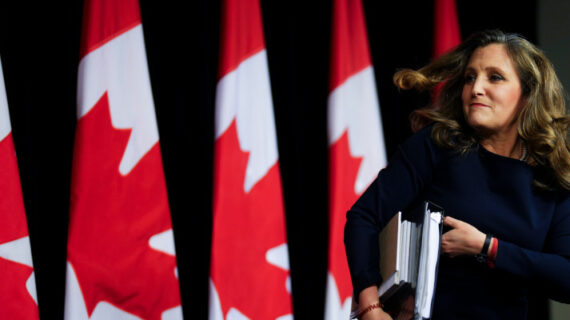Most media coverage of the 2023 federal budget has overlooked the following proposal:
In 2001, Canada Mortgage and Housing Corporation (CMHC) launched the Canada Mortgage Bond (CMB) program to help stabilize access to mortgage funding in all economic conditions. CMBs carry the full faith and credit of Canada and constitute a direct, unconditional obligation of Canada. However, despite carrying the same credit rating, CMBs are a more costly form of borrowing compared to regular Government of Canada bonds. In this context, consolidating CMBs into the regular Government of Canada borrowing program represents an opportunity to reduce debt charges and reinvest savings into important affordable housing programs. The government intends to undertake market consultations on the proposal to consolidate the Canada Mortgage Bonds within the government’s regular borrowing program, including on an implementation plan that would ensure stable access to mortgage financing. The government will return in the fall economic and fiscal update on this matter.
Although at first glance this idea seems innocuous, it potentially has major consequences that the global bond markets are just beginning to digest.
First, some background. Many Canadian mortgage borrowers (often those without access to large down payments) need to access financing through insured mortgages. This is facilitated by mortgage lenders who originate each mortgage, purchase insurance from CMHC (Canada Mortgage and Housing Corporation) and private providers, and then pool mortgages to create NHA (National Housing Act) MBS (Mortgage Backed Securities). These NHA MBS are then sold in the market to raise the required funds.
Although NHA MBS have the highest credit quality (CMHC is explicitly guaranteed by the federal government), owning them exposes investors to prepayment risk and administrative burdens. NHA MBS are, therefore, an inherently illiquid product with a relatively small investor base, trading around GOC+50, i.e. 50 basis points higher in yield than Government of Canada bonds.
Around the turn of the 21st century it was clear that the bespoke nature of NHA MBS was limiting the growth of the Canadian mortgage market. Mortgage originators could not find enough buyers of NHA MBS and had to use more expensive capital to run their businesses, resulting in higher borrowing rates for consumers. In 2001, CMHC solved this problem by creating the Canada Housing Trust (CHT). CHT is a conduit that takes NHA MBS from mortgage originators and issues a simple debt instrument—the Canada Mortgage Bonds (CMBs) against them. CHT centrally manages all the prepayment risk (which it hedges efficiently through the swap market) and administrative burdens associated with NHA MBS.
The CHT and the associated CMB program have been an unequivocal public policy success. Together, they have lowered the cost of insured mortgage credit by transforming a complicated illiquid product, NHA MBS, into a simple liquid product, CMBs, which now trade around GOC+30, an improvement of 20 basis points. CMBs have even attracted a significant number of international investors to increase their allocation to the Canadian bond market. About $85 billion of the CMB float of $260 billion is bought by foreigners. This sizeable foreign investment is a great success of the current program.
The most charitable interpretation of the government choosing to eliminate the CMB program is that of a simple misinterpretation of a complicated combination of cash flows. The interest paid by CMBs, although guaranteed by CMHC, is not paid by the federal government. The key line suggesting a misunderstanding in Ottawa is:
“However, despite carrying the same credit rating, CMBs are a more costly form of borrowing compared to regular Government of Canada bonds.”
Nowhere in the federal budget is there a provision for interest paid on CMB bonds. These appear in the financial statements of CMHC and they are more than offset by interest received from NHA MBS. The cost of borrowing is paid by Canadians who take out insured mortgages. CMHC pays significant dividends (roughly $1 billion last year) to the federal government. The $260 billion CMBs outstanding is equivalent to about a quarter of the Canadian federal debt outstanding, which is now over $1 trillion.
The proposal in the budget could also mean that the federal government plans to borrow roughly an additional $260 billion ($45 billion per year) and use the proceeds to purchase CMBs, in effect lending money directly to Canadians who require insured mortgages. This is not akin to quantitative easing, a monetary policy tool; rather, it is fiscal policy. De facto, the government would act like a fixed-income arbitrage hedge fund, borrowing money to buy high-quality financial assets. Perhaps (in a less charitable interpretation) the government believes that the mere existence of federally guaranteed bonds not originally issued by it represents an investment opportunity it can take advantage of with borrowed money.
This is a rabbit hole that Canada does not want to go down. When a government collects insurance premiums on assets, it doesn’t follow that they should also go on to purchase them. Moreover, if the government actually wanted to increase GOC issuance to target bonds that are guaranteed by them but have higher yields than their own bonds, there are billions of bonds (including NHA MBS outside the CHT) that it could purchase more cheaply than CMBs.
One example is the Muskrat Falls and Labrador Transmission Link Financing bonds, which somehow also contain a federal government guarantee. And what about the implicitly guaranteed (about another $1 trillion) provincial debt? Should the federal government try to make money purchasing those bonds? I believe it is fundamentally inappropriate for the government of Canada to act as the primary lender, effectively setting the market price of credit, for activities it does not directly control.

How will Canadian government bond investors feel about 20 percent of the proceeds of issuance going to purchase assets related to our supply-constrained housing market? The government of Canada currently has access to a liquid and robust market for its bonds. This is an essential public good (the pandemic really demonstrated this) that has been built collaboratively by the Bank of Canada, the well-regulated Canadian banking system, issuers, securities dealers, investors, and successive departments of finance over decades. Global government bond investors want to invest in open economies that have liquid markets, predictable issuance patterns, and stable inflation.
The current Department of Finance already has a history of acting erratically toward the bond market: it cancelled its inflation-linked bond program once realized inflation spiked; it cancelled a 40-year bond auction with little notice; and it has often tried to shift the duration composition of its issuance to game the yield curve. The proposal to buy CMBs, however, would take this adverse behaviour up another level. In the near-term, such action could have materially negative financial consequences for Canadians. Ottawa should think again.
The proposal to buy CMBs runs the risk of raising the Government of Canada’s borrowing costs. Both bond prices and spreads are set by the marginal buyer. A useful way to evaluate the relative expensiveness of government bond issuance is to assess them on spread against the overnight index swap market (OIS)—the best market-based expectation for future interest rates. The government of Canada currently issues debt at around OIS+0. The U.S. Treasury issues debt at OIS+20, so on that metric Canada currently enjoys a relative advantage. How much would that advantage degrade if the government was to suddenly increase bond issuance by 20-25 percent? How would the marginal buyer react? Would the current foreign buyers of CMBs at OIS+30 purchase GOCs at OIS+0 instead? I am sure that most of them won’t, and they are significant ($85 billion) buyers.
The answer to these questions will ultimately be given by the marketplace, but one can attempt an answer. My current estimate, as well as that of some other market participants, is that the change proposed would ultimately cost the government 5-10 extra basis points to service the federal debt once the dust settles. Every basis point costs the taxpayer approximately $250 million dollars annually. This extra cost would at a minimum negate any “savings” achieved by purchasing CMBs. This assumes, of course, that the government matches the duration of their new financial assets with their increased bond issuance. What if they run a duration mismatch and ultimately have unrealized losses on their portfolio (there are recent examples of this south of the border)? How would this be accounted for? Overall, the government’s proposal appears to offer limited upside and contains considerable risks.
Global bond investors will soon realize that the future issuance profile of the Government of Canada is far more uncertain than it was before the budget. This is unfortunate given the current global banking stress against the backdrop of persistently high inflation. The potential to increase Government of Canada borrowing costs and destabilize mortgage market functioning is staring us in the face. As a veteran bond market investor and concerned citizen, I urge the Department of Finance to quickly backtrack on this proposal and affirm that the Canada Housing Trust will continue to support the Canadian housing market in its current form.




